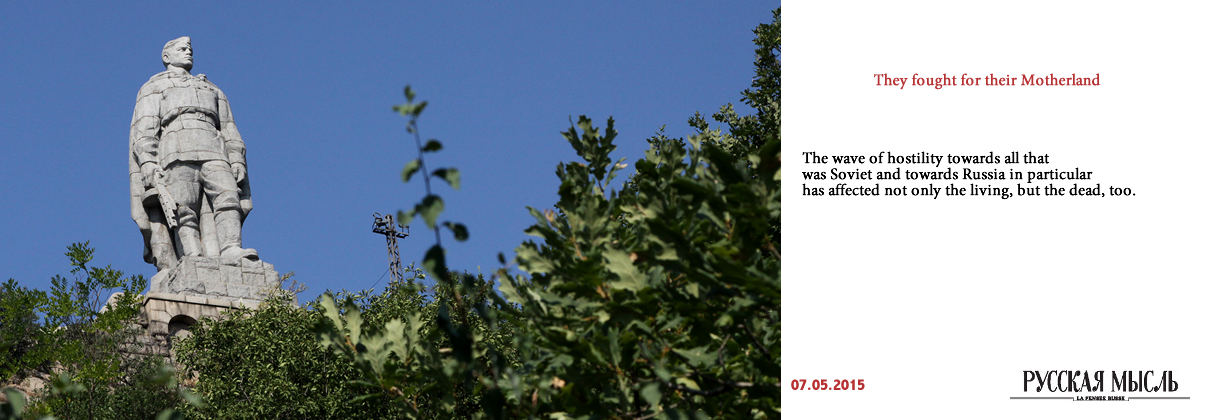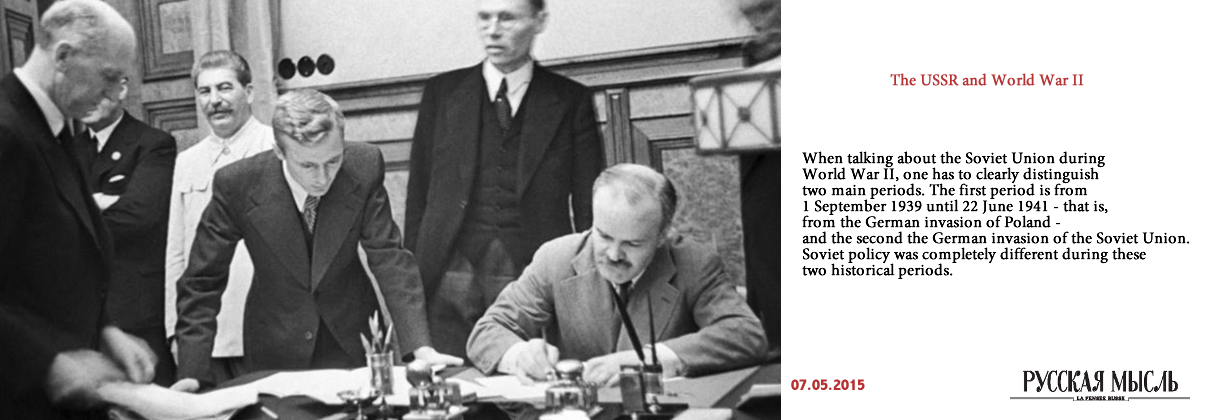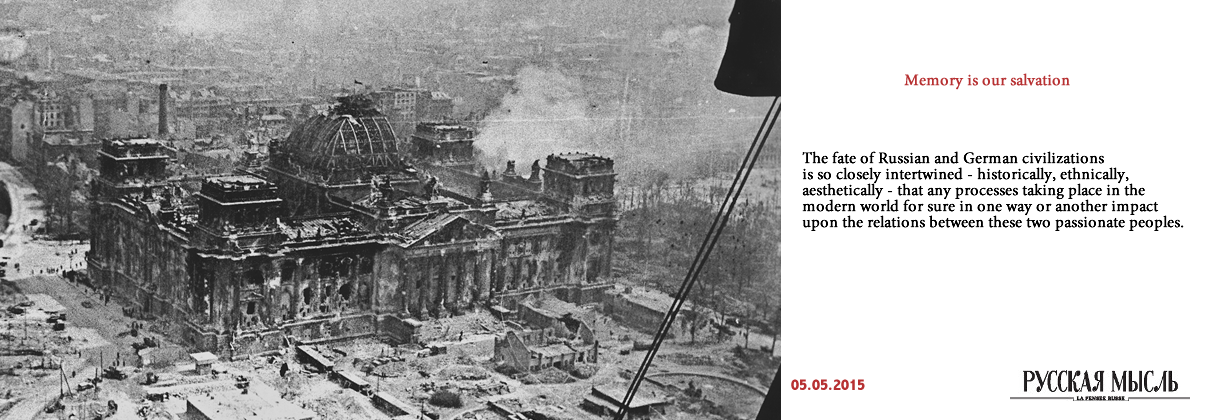Author: Dina Go
The wave of hostility towards all that was Soviet and towards Russia in particular has affected not only the living, but the dead, too.
In memory of the military exploits of the Soviet people and the armed forces during World War II, in gratitude for the liberation of peoples from fascism and in honour of the fallen heroes who died for a righteous cause in Russia, as well as in the countries of Central and Eastern Europe, numerous architectural and sculptural complexes have been erected, along with monuments and obelisks.
In Europe there are about 4,000 military memorials, where over 2.5 million soldiers and officers of the Red Army who died during World War II are buried.
The highest number of Soviet soldiers-liberators lost their lives on the territory of Poland (over 600,000 people). In this country there are 561 monuments and 638 graves of soldiers (including 160 mass graves) from World War II. The most famous and largest burial area is a cemetery and mausoleum of the Soviet soldiers on the way to Warsaw International Airport. 22,000 Soviet soldiers rest in peace there. There is a joint monument to the Soviet and Polish soldiers in Warsaw’s Praga district.
There are 57 monuments devoted to the Soviet soldiers in the Czech Republic and Slovakia (which used to be a single state until 1993). All of them are under state protection.
In 1960, in Bratislava, on the site of a former cemetery of Soviet soldiers, a memorial was built by sculptor Alexander Trizulyak. The memorial itself, as well as the former cemetery, covers an area of 10,000 square metres. 6,845 Soviet soldiers rest in peace here.

In the centre of the memorial there is a pylon of 42 metres in height. The memorial also has a bronze statue of a Soviet soldier-liberator, with a raised flag.
Inside the memorial there is a mourning hall with a bronze double wing door. There are eight bas-reliefs on which are depicted different episodes from the struggle for the liberation of Czechoslovakia from Nazi invaders. On the outer walls of the mourning hall there are inscriptions telling the story of the battles fought by the Red Army and the Czechoslovak Army Corps on the Dukla Pass on the Czechoslovak-Polish border from October 1944 to 4 April 1945. On this day Bratislava itself was liberated from the German occupiers.
More recently, a state programme for the maintenance of soldiers’ monuments has been launched in Slovakia, where more than 60,000 Soviet soldiers were killed during its liberation in 1944. The residents of the country take constant care of individual graves and memorials.
Germany is considered to be a model of a civilized attitude towards the monuments and memory of fallen soldiers. In 1993 the government of the Federative Republic of Germany incurred all the costs for the maintenance of the memorials of those killed during World War II, as well as of the wartime graves located in its territory.
The most famous monument to the Soviet soldiers who fell in the fight against fascism (a soldier with a saved German girl in his arms, which became a symbol of the victory over fascism) was inaugurated on 8 May 1949 in Treptower Park, in south-west Berlin.
A 13-metre bronze statue of a Soviet soldier is the work of the famous sculptor Yevgeny Vuchetich. The bronze fighter holds a girl with his left arm, while in his right hand he holds a sword that cuts the Nazi swastika. The prototype of the Bronze Soldier was Soviet sergeant of the 220th Guards Rifle Regiment of the 79th Guards Division Nikolai Masalov. On 26 April 1945, during fighting in the centre of Berlin, sergeant Masalov took a three-year-old German girl away from the shelling. Another Soviet soldier, the infantry platoon commander Viktor Gunaza, posed for sculptor Yevgeny Vuchetich.
The history of the restoration of the memorial is an interesting one. When in 2003 parts of the monument had to be renovated, it was divided into 44 pieces and sent to the island of Rügen for seven months. Only the soldier’s head itself weighed 1.5 tons. Overall, the impressive sum of 1.5 million euro was spent on the last renovation.
The memorial in the Tiergarten is the only one in West Berlin. It was placed immediately after the liberation of Berlin on a symbolic crossroads – in the immediate vicinity of the Reichstag. 2,500 soldiers of the Red Army who died in the battle for Berlin rest in peace here.
A sensational story relates to tanks in the Tiergarten. The newspapers “Bild” and “Berliner Zeitung” filed a petition to the Bundestag with the requirement to remove the Soviet tanks from the centre of Berlin in connection with the position of Russia on the Ukrainian question. “Russian tanks out of the Brandenburg Gate” – this was the headline of the leading tabloids of the country. It is worth noting, however, that even in this statement which is anti-Russian in spirit, the journalists included an important disclaimer: “With this proposal we do not want to deny our respect and reverence for the memory of the immeasurable sufferings and sacrifices of the Russian people during World War II. And we think that the memory of those soldiers of the Red Army that were buried at the memorial will persist.”
The authorized government official, Chancellor George Shtrayter, rejected the appeal to remove the tanks and made an official statement which said: “The German government holds in high respect the memory of those soldiers of the Red Army who were killed during World War II.”
The celebrated monument to a soldier-liberator, the famous ‘’Alyosha’’ monument, was placed in Plovdiv more than 50 years ago. Despite the fact that the monument was erected in honour of an unknown soldier, it was given a name. “The Russian soldier Alyosha is standing on a mountain in Bulgaria,” – these are the words of Eduard Kolmanovski’s song and Konstantin Vanshenkin’s lyrics that are known literally all over the world. “Alyosha” is not a collective image. In fact, the monument had a real prototype – Siberian soldier Alexei Skurlatov. In September 1944, the soldier and signalman Skurlatov were placing a telephone cable not far from Plovdiv. One of the locals made a sketch of the Siberian hero. This sketch fell into the hands of the Alexei Skurlatov’s Bulgarian comrade Metodi Vitanov. When after the war a group of sculptors – Todor Bosilska, Lubomir Dalchev, Alexander Zankov, Alexander Kovachev, George Kotsev and Vasil Radoslavov – started to work on the monument to the Soviet soldier-liberator, Metodi Vitanov gave them the sketch of Alexei Skurlatov. The sculptors decided to make a monument using it.
The situation around the monument is ambiguous. Requests were made to demolish the monument in 1989, but they were rejected by the authorities. Later, in 1996, the city parliament of the capital Sofia decided to remove the monument, but the decision was appealed in the higher courts, and ultimately the Supreme Court of Bulgaria ruled that the monument “Alyosha”, as a monument dedicated to World War II, cannot be demolished.
In recent years, a Hungarian campaign to remove a monument from the centre of Budapest has been gaining momentum. It relates to a monument to the Soviet soldiers who died in the battle for the city during World War II. But the campaign organizers emphasize that they are calling for the removal of the monument and not its destruction. The monument in memory of the Soviet soldiers who were killed in the fight for Budapest at the end of 1944 stands in the centre of the Hungarian capital in Liberty Square between the television centre and the US Embassy. It has been the target of attacks of Hungarian nationalists several times.
There are also similar monuments to Soviet soldiers in the Netherlands, Norway, Finland, France, Romania and many other countries. Recently a monument to Soviet soldiers who fought during World War II has been inaugurated in Los Angeles. It is a block of granite weighing 7 tons, which depicts flying cranes, and the lyrids of the famous song written by Rasul Gamzatov are carved on it.
Unfortunately, there are examples of different attitudes to monuments and memory. In some countries there are politicians who have chosen to assert themselves by demolishing not just simple monuments but also historical truth and historical memory, ignoring the fact that to remember means to prevent the repetition of same mistakes.
Everyone knows the story of the “Bronze Soldier” in Tallinn (Estonia), as well as the repeated attempts of the Lithuanian group “Sąjūdis” to convince the authorities to dismantle Soviet monuments in Lithuanian cities and transfer them to “a more suitable place”. In 2007 local activists from the Polish city of Katowice offered to erect a statue of the former US President Ronald Reagan on the site of the memorial to the Soviet soldiers. According to the officials, Reagan deserves a monument more than the soldiers of the Red Army.
In contrast to the trend of destruction of monuments devoted to Soviet soldiers, the members of the military and history club “Kursk”, founded by the former military man and policeman Jerzy Tyts, are fighting for the preservation of monuments, and have been restoring them at their own expense.
Over the past few years the press has published information about vandalism against monuments to Soviet soldiers in Poland. Following World War II many Polish cities and towns have graves of Soviet soldiers and officers. The Red Army lost 600,000 soldiers during the liberation of Poland. During the Soviet era the monuments were kept in good condition and well-maintained. After the disintegration of the “socialist camp” the situation has radically changed. The wave of hostility towards everything that was Soviet and towards Russia in particular has affected not only the living, but the dead, too, and the monuments to Soviet soldiers began to be seen as “symbols of occupation.” Since the early 1990s, the Polish authorities have dismantled several major monuments to Soviet soldiers. Dozens of monuments have been vandalised. Sometimes the local authorities themselves call for the demolition of the monuments, on the grounds that they are allegedly in poor condition and that there are no funds for their restoration.
This October the Russian Foreign Ministry was forced to intervene when unknown persons desecrated monuments to Soviet soldiers in the cities of Pruszcz Gdanski (Pomeranian Voivodeshp) and Nowy Sacz (Malopolska Voivodeshp). “We believe that the war against the monuments and, even more, against the memory of those who gave their lives for the freedom and independence of the Polish people is incompatible with the principles on which civilized communities are based,” emphasized the Foreign Ministry. Russian diplomats demanded that the Polish government comply with the 1994 agreement on the protection of graves and monuments to the victims of wars and repression, and take measures in order to identify the vandals and prevent such incidents in the future.
In response to the growing trend towards Russophobia, the military-patriotic club “Kursk” appeared in Poland in 2008. One of its tasks is the restoration of the monuments to the Soviet soldiers which have been destroyed or are in poor condition.
Here is what Jerzy Tyts has told our correspondent about the goals of the organisation: “Russophobia in Poland has reached its climax because of politicians (including the president). We are forced to like the Nazis and Bandera supporters, hate the Russians and everything connected with Russia. The main objective of our association is the fight against Russophobia, the attempts at misinterpreting history and the authorities’ wish to initiate confrontations with our eastern neighbours. The renovation of monuments is just one of the fronts of our particular “war.” The name of “Kursk” has been chosen to commemorate the victory over fascism in the Battle of Kursk. “
A question arises spontaneously: why does this 47-year-old Pole have such respect for the memory of the Soviet soldiers and positive feelings towards Russians? That’s how Jerzy Tyts explained it himself: “Your soldiers drove the Germans from my land and retaliated against the Nazis and Bandera supporters for the perceived wrongs that the Poles suffered. Everyone knows about it. Your soldiers saved my mother and her family from death in 1945. The soldiers of the Red Army had been supplying my mother’s family with food and she always told me: “Son, the Russians were such good people.” I believe her and I will always cherish the memory of the Red Army soldiers. “
Given the current situation, the Polish attitude to the activities of the association “Kursk” is ambiguous. “There are a lot of people who treat my activities with respect but, unfortunately, there are more opponents – says Jerzy Tyts. – I am constantly being bullied, and it’s not just the usual vandals. The largest Polish newspaper (Gazeta Wyborcza) has published an article about me, where it wrote that I am “’Putin’s troll”, a “Russian paratrooper on Polish land.” Serious professors from different universities say that all those who treat the USA and the EU badly must necessarily be made to shut up because all of them are “Putin’s spies.'”
Jerzy Tyts and his organization accept “only brave people who are ready to stand up for their beliefs, if necessary.” But mostly people are afraid. The Association operates using its own funds (annual contributions) and, from time to time, internet fund-raising is organized in order to repair some specific monument. Jerzy Tyts often repairs monuments himself.
Despite the difficulties, the organization has actively been working for two years. It has repaired two cemeteries (506 tombstones), 7 soldiers’ graves and 7 monuments. “Kursk” is also engaged in searching activities: the burial sites of 11 Soviet soldiers who have been considered missing, as well as their relatives, have been located.
It would be wrong to say that all the municipal authorities in Poland are in favour of demolishing the monuments. Fortunately, there are also some that have allocated funds for their restoration. Despite this, the organization has got a lot of work: Jerzy Tyts has made a list of monuments to Soviet soldiers in Poland which have been destroyed through vandalism, which are in poor condition. New monuments are being added to this list all the time, and “Kursk” needs help.
Not everyone in Poland, and especially abroad, is aware of the existence of the association. The Russian media were the first to report on them: last autumn there was a broadcast about a monument restored by the organisation on the channel “Vesti”. Jerzy Tyts was invited to take part in one of the programmes of the channel “Russia”.

One should not be like the extremists with their one-sided view of the world, and believe that anti-Russian sentiments reign in Poland. There are people who do not hate Russia in the country, but remember the heroism of the Soviet soldiers during World War II and respect the memory of those killed on Polish land. In Poland there are people such as Jerzy Tyts and his organisation “Kursk”.
With the support of: the newspaper “Culture”, the Foreign Military Review, the Russian Foreign newspaper and the Russian military-historical society.




